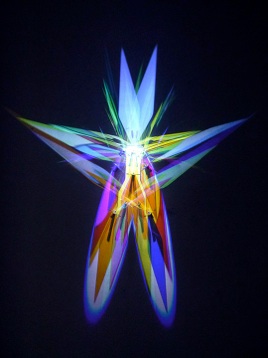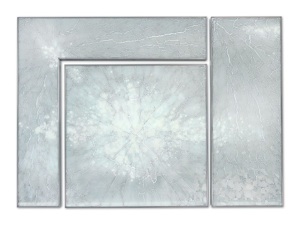Shattered: Defying Expectations in Glass
June 5 - July 30, 2015
Shattered: Defying Expectations in Glass
June 5 - July 30, 2015
Chandra Cerrito Contemporary




Chandra Cerrito Contemporary is pleased to present Shattered, a group exhibition in celebration of the annual GAS (Glass Art Society) conference, held this year in San Jose. This exhibition includes artists from Northern California and beyond whose works incorporating glass are more aligned with contemporary sculpture or installation than with traditional art glass.
Today, glass artists are breaking the mold and pushing their practices far beyond the utilitarian factory objects and decorative studio vessels of times past. The artists featured in Shattered blend traditional glass working methods (blowing, casting, lamp working) and materials (mirrors, uranium glass) with new technologies (low rpm motors, 3D scans and prints, LEDs) creating sculptural artworks and encompassing installations.
Lynne-Rachel Altman’s Drawing Permeable Containment explores “separation anxiety” by the performance-like act of dripping ink through wall-mounted sintered glass pockets. Ink stains resulting on the wall and floor reference “permeability, capillary movement, holding and loss.” A nod to sculptural sensibilities and practices, these glass pockets were formed from molds of metal pour cups at the Crucible, an industrial arts educational facility in Oakland, CA.
In a more painterly form, Cassandria Blackmore reverse paints glass, and then shatters it, creating a sublime landscape of cracks, frozen in time. “It’s the essence of breaking down an image and restoring it to another version of itself that intrigues me.”
Defunct typewriters, old cameras and rotary telephones are cast in clear glass in Jen Blazina’s nostalgic sculptural objects, which sometimes incorporate printmaking and photography techniques. By combining processes and co-opting outmoded tools, the artist is able to “recast the history of the objects as part of (her) own current voice.”
The aesthetic qualities inherent in contemporary industrial materials inform the work of Randy Colosky. Similar to Altman’s appropriation of metal pour cups, Colosky deconstructs the process of making metal sculpture, revealing the “underside” of lost wax casting. Leftover sprues (used as channels for molten metal during the casting process) become the principal, repeated form for his cast glass works.
Thérèse Lahaie’s scoured glass mirror throws light across and around the gallery. Powered by low RPM motors, this kinetic work conjures an ancient, meditative, watery rhythm of light and shadow mediated by modern mechanics.
In Helen Lee’s work, cursive blown glass letters of the word “penmanship” are lit by motion-triggered LEDs, engaging the viewer in an exploration of language. The artist is “interested in the complexities that arise when one thing becomes another. This curiosity traverses a circuit of relationships between: the body and language / language and design / design and glass / glass and the body. How does breath become sound become spoken word become written word become dimensional form, shaped by breath?”
Cathy Cunningham-Little conducts almost scientific investigations to examine visual perception through the use of light and glass. Wall-mounted shards of dichroic glass (the kind developed by NASA) transmit one color and reflect their complementary color. With deliberate placement and careful mixing of light, defined shapes of color appear as ethereal “paintings.”
Clifford Rainey’s torso, posed similarly to Auguste Rodin’s classical sculpture The Age of Bronze, was 3D scanned and printed to create the mold in which he cast uranium glass that fluoresces green. This glass mixture with trace amounts of uranium, common in mid-19th century glass, is illuminated using UV light, which is used in contemporary medical imaging and security applications.
Weaving science with art, David Ruth created molds of glacial rocks and ice while in Antarctica in 2006 as part of a National Science Foundation Grant for artists. Since then, he has continued to cast glass sculptures reminiscent of the glassy, blue-green caves and icebergs from his exploration.
Kana Tanaka often explores perception using repetition, immersive installations, and the light-bending properties of glass. Her work entitled Space Between and Beyond is comprised of glass formed by lamp working and threaded with metal loops that pierce the wall. It evokes organic forms like rain, dew, water, and stars in the sky.
With a wide variety of approaches, the artists in Shattered utilize an ordinary material commonly regarded for functionality, static beauty, or eye-catching color, and transform it to conjure the nearly intangible: psychological states, nostalgia, light, language, perception, water, and space.
-Ginny Tominia
Cassandria Blackmore
Asimi Lefko II, 2015
reverse painted glass
40 x 56 inches
Cathy Cunningham-Little
Transforming Isomer, 2015
glass, stainless steel, white LED
52 x 48 x 4 inches
Lynne-Rachel Altman
Cassandria Blackmore
Jen Blazina
Randy Colosky
Thérèse Lahaie
Helen Lee
Cathy Cunningham-Little
Clifford Rainey
David Ruth
Kana Tanaka


